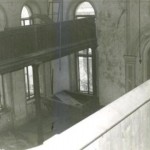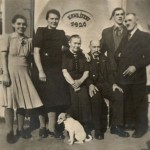Jewish Community
The Jewish community of Reinchenbach / Dzierżoniów
If you do not have an opportunity to visit, you will enjoy this short, but fascinating history.
The early times of Jewish life in Reichenbach are shrouded in darkness. We only know that, as in other towns in Silesia, during the late Middle Ages Jews were expelled and probably fled to the larger towns of the province, where strictly defined ghettos existed. But the largest number emigrated to the Kingdom of Poland where Jewish people lived in relative freedom and were able to develop thriving Jewish communities with a rich cultural and religious life. In 1807 civic reforms were introduced in Prussia by the Baron von Stein, and the Jews living in the Kingdom of Prussia gained equal rights and freedom of movement. What this meant for the town of Reichenbach was recorded by a member of the Jewish congregation in the annals of the synagogue:
“As most Jewish communitities of Lower and Central Silesia had to be abandoned because of persecution and expulsion, and only with the more humane approach of the new times at the beginning of our century [the 19th century] could they awaken to new life, so it also happened in our own Jewish community of Reichenbach. With the bestowing of civil rights to the Jewish people in 1811, they received the right to leave the old in 1815 a few Jewish families also settled as traders here [in Reichenbach]. With more people moving here, by the year 1823 they already felt strong enough to unite as a community and took special preparations to offer cultural and religious instructions. In 1825, they bought a piece of land for a cemetery, where already in 1826 the first burial took place.
At that time, the community consisted of the following members:
Merchant – F. Naphtali
Merchant – Heller
Merchant – Nehemias
Distiller – Lax
Distiller – L. Naphtali
Trader – B. Neuländer
Trader – A. D. Hirsch
Trader – A. Stern
Trader – Mathias Cohn
Who functioned as religious official at that time is unknown today. Only towards the end of the 1830s, we meet Mr. Mayer Oelsner as cantor, shochet, and teacher of religion, who however, was already replaced in 1841 by a Mr. Breslauer. The reform movement of Judaism did not ignore our community. When at the end of the 1840s it had grown to 22 members, they demanded a modern service, embellished by a choir and by prayers in the German language. But since the older ones did not want any changes, this disagreement led to the separation of the older members from the free thinkers. The first group under Mr. Loebel Naphtali retained possession of the synagogue and the property of the community and kept their preacher. The other group arranged their own services and called Mr. Heinrich Schwarz from Rawitsch who organized a service with a sermon and with a choir and musical accompaniment.
After more than four years of separation, the two groups were united, but the modern arrangements were retained. In 1859, Schwarz left his position, and in his place Mr. Moritz Cohn from Rawitsch was summoned as preacher, teacher of religion, shochet and cantor. During this time, the congregation grew so substantially, that it was able to build a new synagogue, which was consecrated on the evening of Shawet 1875. In 1884, the entire congregation gathered for a festive celebration in honour of the 25th anniversary of Mr. Moritz Cohn. Because of his failing health, Mr. Cohn left his position in September 1889 and the congregation rewarded him for his long and faithful service with a yearly pension of 900 Marks. Mr. Jacob Bär from Königsberg/Prussia was selected in July 1889 as his successor. It was Mr. Bär who, with the encouragement of Mr. Jacob Engel, member of the Board, created this history.” [read footnote 1]
The Jewish community of Reichenbach to which belonged a number of the prosperous factory owners and merchants of the city, continued as a thriving community until January 30, 1933, when Hitler took power. But already at that time, the community no longer had its own preacher. The rooms where Moritz Cohn and his family of four children had once lived [read footnote 2] , now accomodated the Kaminski family from Beuthen/Bytom in Upper Silesia. Through an agent, the family had purchased a townhouse before leaving Bytom. But when they arrived in 1930 in Reichenbach and were found to be Jewish, the city, owner of the house, rescinded the purchasing contract. Josef and Amalie with their children Susi and Heinz did not find other accommodation in town and thankfully accepted the offer by the Jewish communtiy to live in the former preacher’s apartment in the synagogue. Josef Kaminski, an active businessman and faithful member of the community, created a Jewish youth hostel in a new addition to the synagogue, which was much frequented by Jewish youth groups and sports teams.
Sometime before 1938, the synagogue with its piece of land was put up for auction by the city administration of Reichenbach and was acquired by Mr. Konrad Springer, who for a number of years had already looked after the Jewish cemetery. It is assumed that Mr. Springer was helped by receiving sufficient funds from the Jewish communtiy to be able to bid for the synagogue property. It is also reported that the mayor of the town, Kurt Dzierzon and possibly one or two town council members were aware of the plan and did nothing to stop Konrad Springer from successfully bidding for the synagogue property.
During the Kristallnacht on November 9/10, 1938, when practically all of Germany’s synagogues were destroyed and burned to the ground by the Nazis, the Reichen bach synagogue was probably the only synagogue in the Province of Silesia that remained totally untouched, because at that time, it was no longer a property in Jewish hands. But during the Kristallnacht, Mrs. Amalie Kaminski and her two children Susi and Heinz were forcefully evicted by the SS. They were only in their night clothes. but they were dragged through the snow to the Cohn villa where the other Jews had been assembled. Mr. Josef Kaminski had already been arrested several weeks before and was taken to the concentration camp of Buchenwald. A few weeks after the Kristallnacht, Mr. Kaminski returned from Buchenwald weak, emaciated and frightened. Fortunately,the family soon succeeded in emigrating to Bolivia. [read footnote 3]
The synagogue remained untouched, but it is a sad fact, that at the beginning of 1939 the Hitler Youth moved into the synagogue that from then on until 1945 served as headquarters for the local leader of the Hitler Youth. However, after this degrading period, the synagogue would reawaken to renewed Jewish life!
Reichenbach becomes Rychbach and finally Dzierżoniów
Reichenbach was occupied by the Red Army only on the day of the Armistice of 1945. In the surrounding area with its numerous Außenlager that were part of the concentration camp of Groß Rosen, the Red Army liberated thousands of survivors who soon came streaming to the undestroyed City of Reichenbach; they were joined by Jews from camps in other areas of Poland and Eastern Europe. A thriving Jewish city sprang up in Reichenbach that was given the name of Rychbach, with a synagogue, a club house, with schools, health facilities, newspapers and theaters. Among the thousands there was not a single German Jew from the former German-Jewish community of Reichenbach. The number of Jewish people living in Rychbach ranged from 17 500 right after the war to between 6000 and 3 500 in the years 1950 to 1968. A few days after the Armistice, services were held again in the synagogue. A plaque was placed on the outside wall, recognizing the services of Konrad Springer as the saviour of the synagogue during the Nazi years:
“This historical synagogue was built in the year 1875 and served the Jewish community until the year 1937, when the National Socialist administration of the city expropriated the building and sold it to the gardener Konrad Springer, who without any claim handed it over to the group of Polish Jews in Rychbach.”
The synagogue was officially reopened in May 1945 and, newly blessed, was serving the Mosaic faith until 1980. But already in the 1960s, the Jewish citizens began to leave Poland, emigrating mainly to Israel und to the United States. In 1980, only a very few Jews remained in the city and the synagogue was closed.
Abandoned, the Synagogue was left to decay, untill the Beiteinu Chaj-2004 Foundation began with the work of its rescue.
© John Koch 2009
- Some of the registers and annals of the synagogue were microfilmed and are now in the archives of the Church of Jesus Christ of Latter Day Saints in Salt Lake City, Utah. [↩]
- Moritz Cohn died on February 25, 1891 in Berlin. His wife Auguste, née Teplitz had died October 16, 1890; her gravestone is still stands in the Jewish cemetery. Moritz Cohn and his wife Auguste had four children: Theodor emigrated to England as a young man; Julius died as a soldier in the Franco-Prussian War of 1870/71; the only daughter Malwine Joel née Cohn was murdered in a concentration camp; Martin emigrated to Canada in 1906 where he explored coal deposits in the Rocky Mountains of Alberta and built a coal mine and a town which he gave his name of Nordegg that he had adopted in place of Cohn in 1909. The town of Nordegg carries Martin’s name to this day. Until his death in 1948 in New York, Martin was widely respected as businessman, entrepreneur and humanitarian. [↩]
- Susi Klein, née Kaminski now lives in Los Angeles. [↩]








 Polski
Polski